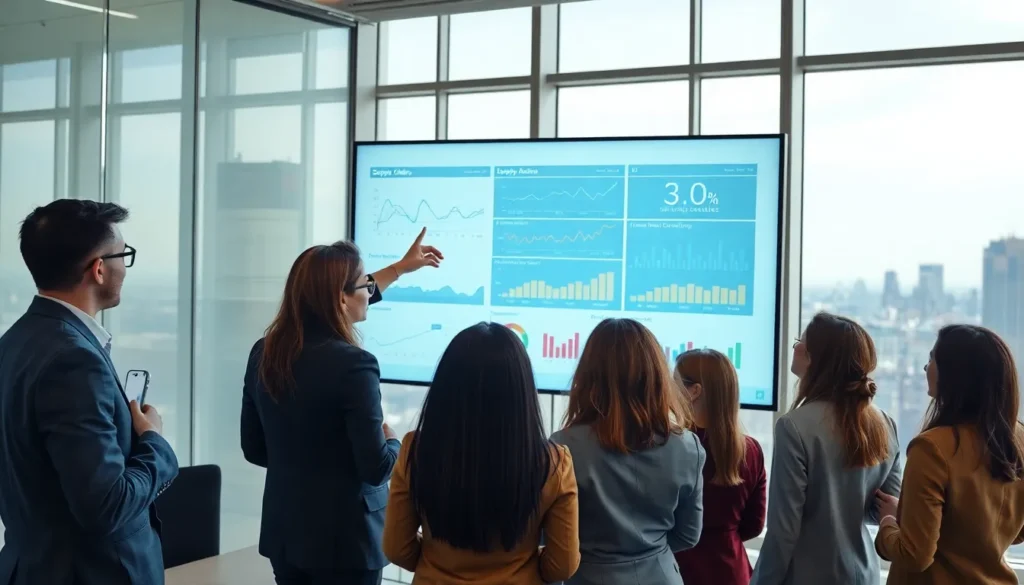In a world where the economy can feel as unpredictable as a cat on a hot tin roof, staying informed is crucial. Whether it’s soaring inflation or the latest job market trends, economic updates are the lifebuoys keeping us afloat in turbulent waters. Ignoring them might just leave you adrift, wondering why your favorite coffee shop suddenly charges a small fortune for a latte.
But fear not! This article dives into the latest economic updates, breaking them down into bite-sized pieces that won’t put you to sleep. With a sprinkle of humor and a dash of insight, it’s time to navigate the financial landscape with confidence. So grab your favorite beverage, sit back, and let’s unravel the mysteries of the economy together. After all, knowledge is power—and it might just help you snag that extra slice of pizza at dinner.
Table of Contents
ToggleOverview of Economic Updates
Economic updates provide crucial insights into trends affecting daily life. Recently, inflation has reached levels not seen in decades, influencing both consumer behavior and spending patterns. Significant price increases in essentials like groceries and fuel create noticeable impacts on household budgets.
Job market dynamics play a pivotal role in shaping economic conditions. Current data shows the unemployment rate holding steady at around 4%, indicating a resilient labor market. Additionally, wage growth remains positive, with many sectors reporting increases that help offset inflationary pressures.
Federal Reserve actions continue to influence economic forecasts and consumer sentiment. Recent interest rate hikes aim to curb inflation, though they also affect borrowing costs. Changes in interest rates can make mortgages pricier, impacting homebuying trends in urban areas.
Global factors are interconnected with local economies. Supply chain disruptions, exacerbated by geopolitical tensions, lead to further challenges, including prolonged delivery times and increased costs.
Consumer confidence surveys reveal fluctuating optimism among Americans. Many individuals remain cautious, monitoring their finances closely amid uncertainties. Shifts in consumer behavior, linked to these economic conditions, are evident as individuals opt for budget-friendly choices.
Tracking these updates ensures a well-rounded perspective on the current economic climate. Awareness of these changes enables individuals to adapt their decisions effectively, whether budgeting for daily expenses or considering long-term investments.
Key Economic Indicators

Understanding various economic indicators provides insight into current financial conditions. Tracking changes in these indicators helps gauge the overall health of the economy.
Inflation Rates
Inflation rates recently reached highs not observed in decades. The Consumer Price Index (CPI) shows an increase of approximately 8% over the past year, particularly impacting essential goods. Rising costs for groceries and fuel directly affect household budgets. Core inflation, excluding volatile items, remains elevated at around 6%. Factors such as supply chain disruptions and ongoing geopolitical tensions contribute to persistent inflationary pressures. Monitoring these rates allows consumers to adapt their spending and saving strategies accordingly.
Employment Statistics
Employment statistics reveal a steady unemployment rate positioned around 4%. Job growth continues with sectors like technology and healthcare posting gains, despite challenges in retail and hospitality. Wage growth remains positive, averaging an increase of 3% annually, helping to mitigate the effects of inflation. Labor force participation rates slightly increased to 61.6%, reflecting more individuals entering the job market. Keeping an eye on these figures empowers decision-making regarding job searches and workforce participation.
Global Economic Trends
Global economic trends are shaped by various factors, impacting both developing and advanced economies.
Developing Economies
Developing economies exhibit growth, influenced by increasing foreign investment and resource utilization. Nations in Asia and Africa experience rapid urbanization, leading to enhanced consumer markets. For instance, countries like India and Nigeria showcase improvements in technology adoption, driving innovation. Job opportunities increase as industries expand, yet challenges remain regarding infrastructure and education. Inflation rates might fluctuate; however, many consumers adapt to these changes. Recent trends indicate an average GDP growth of 5% annually in several developing regions, emphasizing their potential for resilience and expansion.
Advanced Economies
Advanced economies demonstrate stability, though challenges such as inflation and labor shortages persist. Countries like the United States and Germany prioritize technological advancements to boost productivity. Economic data shows that GDP growth averages at about 2% annually, indicating a slower pace compared to developing counterparts. Interest rates rise as central banks respond to inflation, impacting consumer spending. Workers in these economies face greater demands for skills, pushing companies to invest in training programs. Overall, consumer confidence remains cautiously optimistic, reflecting a balance of economic stability and emerging risks.
Impact of Policy Changes
Policy changes significantly shape the economic environment. Two main areas of focus include fiscal and monetary policies.
Fiscal Policies
Fiscal policies influence overall economic performance through government spending and taxation. Increased government spending often stimulates growth, especially when investing in infrastructure and social services. Recent fiscal measures aimed to support struggling sectors during economic fluctuations. Enhanced funding for education and healthcare could improve long-term productivity. Tax reform might also empower consumers, allowing them to increase spending power. Changes in tax rates directly affect disposable income, impacting consumer behavior and overall economic activity. Forecasts suggest that effective fiscal policies can contribute to GDP growth, currently averaging around 2% in advanced economies.
Monetary Policies
Monetary policies play a critical role in managing inflation and interest rates. Central banks adjust interest rates to influence borrowing and spending. Recent rate hikes aim to curb rising inflation, which stands at approximately 8%. Higher interest rates typically slow down consumer borrowing, leading to decreased spending in both retail and real estate markets. However, these changes can stabilize the economy in the long run. Central banks also utilize tools like quantitative easing to inject liquidity into the market, aiming to stimulate growth. Active monetary policies are vital in responding to economic shifts, as they directly impact consumer confidence and behavior.
Sector-Specific Economic Updates
Recent economic changes reflect varying conditions across different sectors. Understanding these nuances helps individuals navigate their financial strategies effectively.
Real Estate Market
Current interest rate hikes have significantly influenced the real estate market. Home prices continue to rise, with median prices increasing by approximately 10% over the past year despite rising borrowing costs. Buyers face mounting challenges as mortgage rates are now averaging around 7%, affecting affordability. Sellers remain active, capitalizing on high demand and limited inventory. Furthermore, the rental market reflects similar trends, with average rent prices climbing by about 5% annually. Adaptation in buying and selling practices becomes crucial as market dynamics shift, affecting all stakeholders involved.
Technology Sector
The technology sector shows robust growth despite overall economic uncertainties. Companies are investing heavily in digital transformation, pushing annual growth rates past 8% in areas like cloud computing and cybersecurity. Talent acquisition remains competitive, with tech firms increasing wages by approximately 4% to attract skilled workers. Recently, innovation is driving job creation while meeting evolving consumer demands. Interestingly, government incentives for tech startups are fostering entrepreneurial activity, reflecting a significant boost in venture capital investments. This pattern indicates a bright outlook, as technology continues to shape the economy’s growth trajectory.
Staying updated on economic changes is crucial for navigating today’s financial landscape. With inflation impacting daily expenses and job markets evolving, individuals must remain vigilant. The resilience of the job market offers some hope amid rising costs while global trends present both opportunities and challenges.
As central banks adjust interest rates and governments implement fiscal policies, the economic environment continues to shift. Awareness of these dynamics empowers individuals to make informed decisions about spending and investing. By engaging with these economic updates, readers can better understand their financial situations and adapt accordingly.









